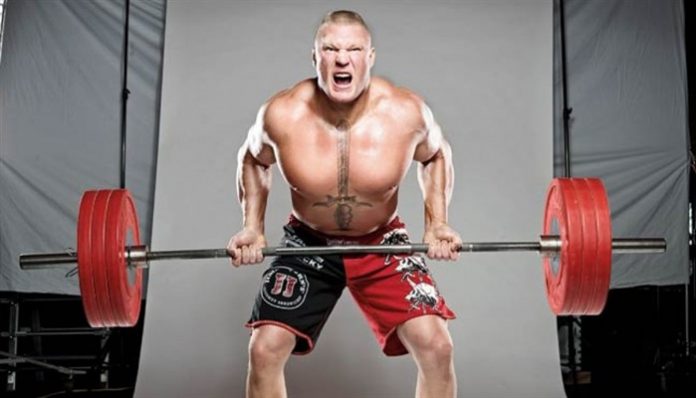
People that train Jiu-Jitsu are usually involved in some sort of weight lifting training as well. The reasons behind lifting weights are different for everyone. Some people like to look good, as simple as that. Others like to lift weights in order to become stronger because it suits their game on the mats. And then there are those who lift in order to return from an injury and prevent further ones. Whatever the case, lifting weights seems to be what grapplers prefer for strength training, despite the proven benefits of bodyweight training. However, weight training requires a lot of time and effort in order to result in benefits. Weight lifting for Jiu-Jitsu is even more complicated because it requires finding that fleeting balance between the two.
Ocham’s razor. These are the only two words you need to remember in when you’re thinking about weightlifting for Jiu-Jitsu. In case you’re not familiar with the concept, Ocham’s razor states that the simplest solution is usually the correct one. When you’re thinking about moving heavy objects in order to improve on the mats, you need to think simple. Complicated programs involving multi-layered periodization and using every gadget that modern gyms have are not a great choice. Nor is going all power-lifter and focusing on single rep max effort work only. But then, what’s the best weight lifting for the Jiu-Jitsu program?
The answer is none. there is no one program that universally works for everyone. Especially when it comes to getting that edge in grappling. The trouble is not just that everyone is different, but that everyone’s BJJ game is different along with their strength abilities, and needs. Those are too many variables to consider from the start. So, before you get lost, dumb everything down and you’ll most likely get to the right solution. weight lifting for Jiu-Jitsu needs to be easy, simple, and minimalistic.
Weight Lifting for Jiu-Jitsu For Jiu-Jitsu Dumbed Down
So do grapplers actually need to include weight lifting for Jiu-Jitsu? The answer is mostly yes. The benefits of lifting weights (correctly) are numerous. We all know that sometimes on the mats, you need to use some strength in order to push a move through. It may be that last couple of inches on a sweep or just a bit more tightness on a choke. Or, you might need to explode in order to finish a pass against an experienced and flexible guard player.
That said, what do grapplers actually get from lifting weights? Well, the goal should be stronger legs, explosive hips, a really strong core, stable shoulders, and a lot of endurance to be able to do all things over and over again. Knowing all of this makes weightlifting for Jiu-Jitsu really simple because it removes the guesswork. But it is just half of the puzzle.
The second half of the puzzle is exercise selection. Not every exercise is a good fit for a grappling strength and conditioning program. So you need to find those exercises that will deliver on the above requirements. Lucky for you, there’s no need for further research. I’m going to outline the only quintet of exercises you’ll ever need below.
That must mean that we’re done right? We dumbed it down as much as possible. Well, almost. There’s the question of programming and it does require some tinkering. The rule of thumb is to go for short sessions with the intensity to match your needs. 3-5 sets is the best and reps should be between 5 and 8. That way you ensure you develop both strength and endurance for the mats.
The Only Weight Lifting Exercises You Need
So, in our Okhams razor style of things, we’re going to explain the few exercises that’ll get you to your goal. And, interestingly, with a few tweaks, this program is going to fit any goal. Fat loss, strength gains, muscle gains, injury prevention, looking good (at least your body)… You can get it all by combining just the following exercises.
Front Squats
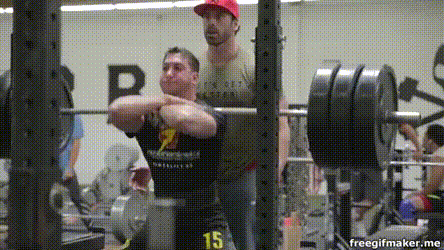
Front squats make your hips and wrists more mobile. They work the core throughout the movement making it stabilize. They work both the pushing and pulling muscles of the legs, as well as the glutes. Front squats also require biceps work (especially Zerchers) and shoulder stabilization. The only thing this exercise lacks is an upper-body pulling motion. A huge benefit of front squats (and all front-loaded exercises) for BJJ is posture.
Overhead Press
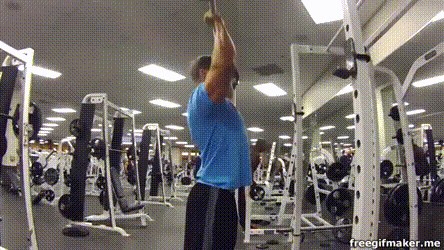
Deadlift
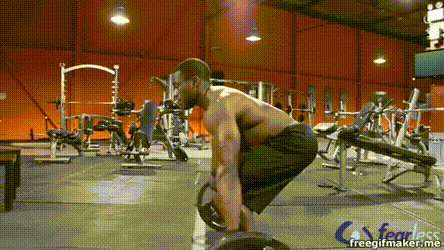
Turkish Get Ups
This is the one exercise of the bunch that fits into any program. Turkish gets-ups are as full body as an exercise can get. It does have a slight learning curve, but once you master it the returns are nothing short of astonishing. The best tool for them is a kettlebell, but dumbells will also do.
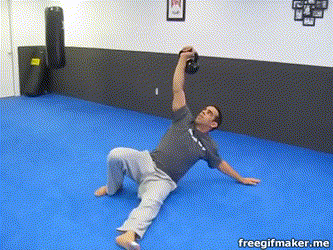
Rowing
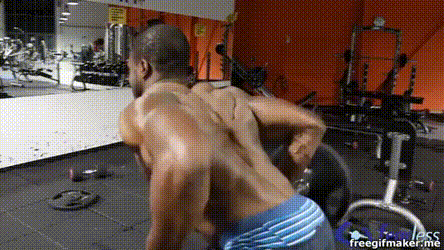
Putting It All Together
In terms of programming, you’ve got two main options here. First, you can do all exercises in one session, keeping an eye on intensity, twice a week with ample rest in between. Or, you can do a split. On one day do front squats, overhead pressing, and Turkish get-ups. On the second go for deadlifts, rows, and again, get-ups. If you want to throw in the third day, make it Turkish get-ups only, or just some simple bodyweight moves. Or, even better, make it another BJJ session instead.
10 Strength and Condition Bodyweight Exercises for Jiu Jitsu – Tutorial
Want The Jiu-Jitsu Body Of Gordon Ryan? Train Like This To get It!
https://bjj-world.com/george-lockhart-nutrition-dvd-book/


![Darce Choke Encyclopedia – Origins, Mechanics and Variations [2025] BJJ, choke, Brabo, BJJ Darce Choke, D'arce Choke, Darce BJJ Choke](https://bjj-world.com/wp-content/uploads/2017/11/JungPoirierLeeYahoo-218x150.jpg)









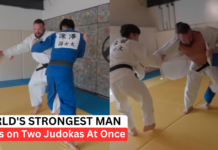

![Slicin’ Calves Mikey Musumeci DVD Review [2025] Slicin' Calves Mikey Musumeci DVD Review](https://bjj-world.com/wp-content/uploads/2025/04/slicin-calves-mikey-musumeci-dvd-review-218x150.png)
![Jiu-Jitsu For Old Guys Guard Retention Bernardo Faria DVD Review [2025] Jiu-Jitsu For Old Guys Guard Retention Bernardo Faria DVD Review](https://bjj-world.com/wp-content/uploads/2025/03/old-guys-guard-retention-bernardo-faria-dvd-review-218x150.png)
![X-Guard Trickery Kyle Sleeman DVD Review [2025] X-Guard Trickery Kyle Sleeman DVD Review](https://bjj-world.com/wp-content/uploads/2025/03/x-guard-trickery-kyle-sleeman-dvd-review-218x150.png)
![Countering with Crab Ride Anthony Budion DVD Review [2025] Countering with Crab Ride Anthony Budion DVD Review](https://bjj-world.com/wp-content/uploads/2025/03/countering-with-crab-ride-anthony-budion-dvd-review-218x150.png)
![Ginastica Natural Alvaro Romano DVD Review [2024] Ginastica Natural Alvaro Romano DVD Review](https://bjj-world.com/wp-content/uploads/2024/12/ginastica-natural-alvaro-romano-dvd-review-324x235.png)


![Assassin Choke Baret Yoshida DVD Review [2024] Assassin Choke Baret Yoshida DVD Review](https://bjj-world.com/wp-content/uploads/2024/10/assassin-choke-baret-yoshida-dvd-review-100x70.png)

![Effectively Passing The Guard Luke Griffith DVD Review [2025] Effectively Passing The Guard Luke Griffith DVD Review](https://bjj-world.com/wp-content/uploads/2025/01/passing-the-guard-luke-griffith-dvd-review-100x70.png)

![The Whole Omoplata Enchilada Lyanne Perez DVD Review [2024] The Whole Omoplata Enchilada Lyanne Perez DVD Review](https://bjj-world.com/wp-content/uploads/2024/11/whole-omoplata-enchilada-lyanne-perez-dvd-review-100x70.png)
![No-Gi Open Guard K-Guard Lachlan Giles DVD Review [2024] No-Gi Open Guard K-Guard Lachlan Giles DVD Review](https://bjj-world.com/wp-content/uploads/2024/12/no-gi-open-guard-k-guard-lachlan-giles-dvd-review-100x70.png)


![The Rack Kyle Watson BJJ DVD Review [2025] The Rack Kyle Watson BJJ DVD Review](https://bjj-world.com/wp-content/uploads/2024/12/the-rack-kyle-watson-bjj-dvd-review-100x70.png)


![Miko Hytonen Lapel Chokes From Everywhere DVD Review [2024] Miko Hytonen Lapel Chokes From Everywhere DVD Review](https://bjj-world.com/wp-content/uploads/2024/10/miko-hytonen-lapel-chokes-from-everywhere-dvd-review-100x70.png)


![Charles Allan Price Building Workouts For BJJ DVD Review [2024] Charles Allan Price Building Workouts For BJJ DVD Review](https://bjj-world.com/wp-content/uploads/2024/09/charles-allan-price-building-workouts-for-bjj-review-100x70.png)

![X-Guard Trickery Kyle Sleeman DVD Review [2025] X-Guard Trickery Kyle Sleeman DVD Review](https://bjj-world.com/wp-content/uploads/2025/03/x-guard-trickery-kyle-sleeman-dvd-review-100x70.png)
![Baseball Chokes From Everywhere Magid Hage DVD Review [2025] Baseball Chokes From Everywhere Magid Hage DVD Review](https://bjj-world.com/wp-content/uploads/2025/01/baseball-chokes-from-everywhere-magid-hage-dvd-review-100x70.png)
![Wristlocks From The Top Pete Letsos DVD Review [2025] Wristlocks From The Top Pete Letsos DVD Review](https://bjj-world.com/wp-content/uploads/2025/01/wristlocks-from-the-top-pete-letsos-dvd-review-100x70.png)
![Master The Move The American Lock John Danaher DVD Review [2024] Master The Move The American Lock John Danaher DVD Review](https://bjj-world.com/wp-content/uploads/2024/12/the-american-lock-john-danaher-dvd-review-100x70.png)
![Breaking Their Guard Mikey Musumeci DVD Review [2025] Breaking Their Guard Mikey Musumeci DVD Review](https://bjj-world.com/wp-content/uploads/2025/02/breaking-their-guard-mikey-musumeci-dvd-review-100x70.png)


![Don’t Stand Up Chris Wojcik DVD Review [2024] Don't Stand Up Chris Wojcik DVD Review](https://bjj-world.com/wp-content/uploads/2024/11/dont-stand-up-chris-wojcik-dvd-review-100x70.png)
